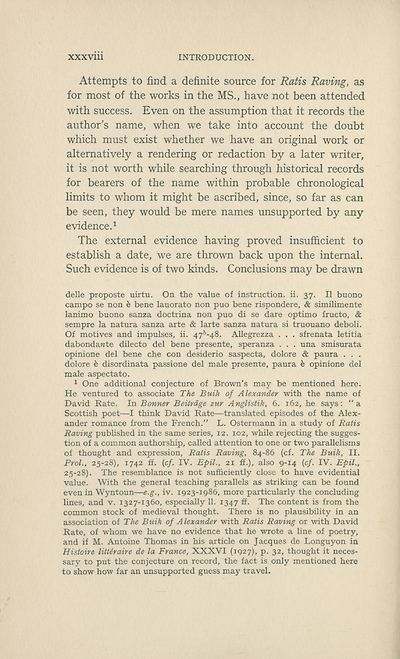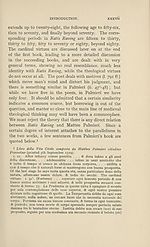Scottish Text Society publications > Third series > Ratis raving and other early Scots poems on morals
(48)
Download files
Complete book:
Individual page:
Thumbnail gallery: Grid view | List view

xxxvm
INTRODUCTION.
Attempts to find a definite source for Ratis Raving, as
for most of the works in the MS., have not been attended
with success. Even on the assumption that it records the
author’s name, when we take into account the doubt
which must exist whether we have an original work or
alternatively a rendering or redaction by a later writer,
it is not worth while searching through historical records
for bearers of the name within probable chronological
limits to whom it might be ascribed, since, so far as can
be seen, they would be mere names unsupported by any
evidence.1
The external evidence having proved insufficient to
establish a date, we are thrown back upon the internal.
Such evidence is of two kinds. Conclusions may be drawn
delle proposte uirtu. On the value of instruction, ii. 37. 11 buono
campo se non e bene lauorato non puo bene rispondere, & similimente
lanimo buono sanza doctrina non puo di se dare optimo fructo, &
sempre la natura sanza arte & larte sanza natura si truouano deboli.
Of motives and impulses, ii. 476-48. Allegrezza . . . sfrenata letitia
dabondawte dilecto del bene presente, speranza . . . una smisurata
opinione del bene che con desiderio saspecta, dolore & paura . . .
dolore 6 disordinata passione del male presente, paura h opinione del
male aspectato.
1 One additional conjecture of Brown’s may be mentioned here.
He ventured to associate The Buik of Alexander with the name of
David Rate. In Bonner Beitrdge zur Anglistik, 6. 162, he says: “a
Scottish poet—I think David Rate—translated episodes of the Alex¬
ander romance from the French.” L. Ostermann in a study of Ratis
Raving published in the same series, 12. 102, while rejecting the sugges¬
tion of a common authorship, called attention to one or two parallelisms
of thought and expression, Ratis Raving, 84-86 (cf. The Buik, II.
Prol., 25-28), 1742 ff. (cf. IV. Epil., 21 ff.), also 9-14 (cf. IV. Epil.,
25-28). The resemblance is not sufficiently close to have evidential
value. With the general teaching parallels as striking can be found
even in Wyntoun—e.g., iv. 1923-1986, more particularly the concluding
lines, and v. 1327-1360, especially 11. 1347 ff. The content is from the
common stock of medieval thought. There is no plausibility in an
association of The Buik of Alexander with Ratis Raving or with David
Rate, of whom we have no evidence that he wrote a line of poetry,
and if M. Antoine Thomas in his article on Jacques de Longuyon in
Histoire litteraire de la France, XXXVI (1927), p. 32, thought it neces¬
sary to put the conjecture on record, the fact is only mentioned here
to show how far an unsupported guess may travel.
INTRODUCTION.
Attempts to find a definite source for Ratis Raving, as
for most of the works in the MS., have not been attended
with success. Even on the assumption that it records the
author’s name, when we take into account the doubt
which must exist whether we have an original work or
alternatively a rendering or redaction by a later writer,
it is not worth while searching through historical records
for bearers of the name within probable chronological
limits to whom it might be ascribed, since, so far as can
be seen, they would be mere names unsupported by any
evidence.1
The external evidence having proved insufficient to
establish a date, we are thrown back upon the internal.
Such evidence is of two kinds. Conclusions may be drawn
delle proposte uirtu. On the value of instruction, ii. 37. 11 buono
campo se non e bene lauorato non puo bene rispondere, & similimente
lanimo buono sanza doctrina non puo di se dare optimo fructo, &
sempre la natura sanza arte & larte sanza natura si truouano deboli.
Of motives and impulses, ii. 476-48. Allegrezza . . . sfrenata letitia
dabondawte dilecto del bene presente, speranza . . . una smisurata
opinione del bene che con desiderio saspecta, dolore & paura . . .
dolore 6 disordinata passione del male presente, paura h opinione del
male aspectato.
1 One additional conjecture of Brown’s may be mentioned here.
He ventured to associate The Buik of Alexander with the name of
David Rate. In Bonner Beitrdge zur Anglistik, 6. 162, he says: “a
Scottish poet—I think David Rate—translated episodes of the Alex¬
ander romance from the French.” L. Ostermann in a study of Ratis
Raving published in the same series, 12. 102, while rejecting the sugges¬
tion of a common authorship, called attention to one or two parallelisms
of thought and expression, Ratis Raving, 84-86 (cf. The Buik, II.
Prol., 25-28), 1742 ff. (cf. IV. Epil., 21 ff.), also 9-14 (cf. IV. Epil.,
25-28). The resemblance is not sufficiently close to have evidential
value. With the general teaching parallels as striking can be found
even in Wyntoun—e.g., iv. 1923-1986, more particularly the concluding
lines, and v. 1327-1360, especially 11. 1347 ff. The content is from the
common stock of medieval thought. There is no plausibility in an
association of The Buik of Alexander with Ratis Raving or with David
Rate, of whom we have no evidence that he wrote a line of poetry,
and if M. Antoine Thomas in his article on Jacques de Longuyon in
Histoire litteraire de la France, XXXVI (1927), p. 32, thought it neces¬
sary to put the conjecture on record, the fact is only mentioned here
to show how far an unsupported guess may travel.
Set display mode to: Large image | Zoom image | Transcription
Images and transcriptions on this page, including medium image downloads, may be used under the Creative Commons Attribution 4.0 International Licence unless otherwise stated. ![]()
| Publications by Scottish clubs > Scottish Text Society publications > Third series > Ratis raving and other early Scots poems on morals > (48) |
|---|
| Permanent URL | https://digital.nls.uk/106919917 |
|---|
| Description | A collection of over 100 Scottish texts dating from around 1400 to 1700. Most titles are in Scots, and include editions of poetry, drama, and prose by major Scottish writers such as John Barbour, William Dunbar, Gavin Douglas, and George Buchanan. Edited by a key scholarly publisher of Scotland's literary history, and published from the late 19th century onwards by the Scottish Text Society. Available here are STS series 1-3. |
|---|

